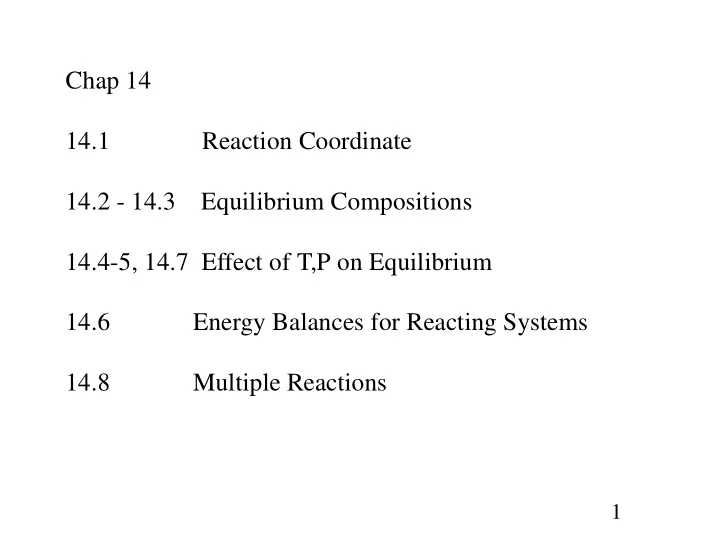

Chap 14 14.1 Reaction Coordinate 14.2 - 14.3 Equilibrium Compositions 14.4-5, 14.7 Effect of T,P on Equilibrium 14.6 Energy Balances for Reacting Systems 14.8 Multiple Reactions 1
14.1 Reaction Coordinate CH 4 + H 2 O = CO + 3 H 2 ν i -1 - 1 1 3 Note: Elliott and Lira ν i is stoichiometric number - USE THIS Felder and Rousseau ν i is stoichiometric coefficient β i is stoichiometric number dn dn = 1 2 ν ν Reaction Coordinate d ξ = dn i / ν i 1 2 2
f i v i ξ n i = n i + At reaction equilibria, Gibbs energy minimized: 3
4
Standard State - denoted with superscript o T of system Specified P o , usually 1 bar or 1 atm Composition State of aggregation 14.2 Equilibrium Constraint 5
Standard State Gibbs Energy of Rxn at T. 6
14.3 Equilibrium Constant for Gas Phase Reaction 7
8
Modification of Example 14.3 CO + 2H 2 --> CH 3 OH · CO 2 n = 1 500 K · H 2 10 bar n = 3 9
Relation of Kinetic Constants to K a for elementary reaction. 10
o and K a ∆ 14.4 Temperature effects on G T . o o ∂ ( G / RT ) H D D T T = - 2 ∂ T RT van’t Hoff Eqn ∆ T ∆ ∆ o o o G H G z = − + T T R dT (14.25) 2 RT RT RT R T R T + z ∆ = ∆ ∆ o o H H C dT T R P T (14.26) R 11
Standard Heat of Reaction o o o ∆ ≡ ∆ ∑ ∑ H R v i H R i = v i H fR i = (14.27) , , o o ν i ∆ ν i ∆ ∑ ∑ H fR i – H fR i , , products reac tan ts 12
13
Eqn 14.26 becomes ∆ ∆ ∆ b T c T d T ∆ = ∆ + ∆ − + − + − + − o o 2 2 3 3 4 4 H H a T ( T ) ( T ) ( T ) ( T ) T R R R R R 2 3 4 ∆ ∆ ∆ b T c T d T = + ∆ + + + 2 3 4 J aT 2 3 4 ∆ ∆ ∆ ∆ ∆ 2 3 o G J a bT cT dT = − − − − + ln T I 2 6 12 RT RT R R R R 14
Example 14.5 C 2 H 4 + H 2 O = C 2 H 5 OH Kcalc.xls 15
Shortcut van’t Hoff ∆ ∆ = − ∆ G I F F I o o o ln K G G H 1 1 J = − − a T R R G J (14.31) H K H K K RT RT R T T aR R R Example 14.6 (repeat Ex14.5 by shortcut method) C 2 H 4 + H 2 O = C 2 H 5 OH 16
17
exothermic endothermic ξ at equilibrium reaction reaction Temperature Qualitative behavior of equilibrium conversion for exothermic and endothermic reactions. 18
15.6 Energy Balances for Reacting Systems Method 1 T in T out in out · i · i ∑ ∑ ∫ ∫ 0 = n C P i dT – n C P i dT + , , T R T R components components · · H R · o ξ ∆ Q + W – S 19
Method 2 · · H in n · in H out n · out 0 = – + Q + W S where T in H in n · in in o ∆ ∑ · i ∫ = n H + C P dT , fR i T R components and T out H out n · out out ∆ o · i ∑ ∫ = n H + C P dT , fR i T R components 20
Adiabatic Reactors T in T out in out · i · i ∑ ∑ ∫ ∫ 0 = n C P i dT – n C P i dT , , T R T R components components · o ξ ∆ – H R Example 14.7 1/2 N 2 + 3/2 H 2 → NH 3 Feed 25°C, 100 bar, stoichiometric feed. Find outlet T, ξ for reaction (provided we get it started). 21
22
Graphical Energy Balance T in T out in out · i · i ∑ ∑ ∫ ∫ 0 = n C P i dT – n C P i dT , , T R T R components components · o ξ ∆ – H R · o ξ ∆ H R T out T in ≈ – - - - - - - - - - - - - - - · C Pm m 23
ξ at equilibrium slope exothermic · C Pm reaction m - - - - - - - - - - - - - - ξ o ∆ – H R T in T out Temperature 24
14.7 Pressure Effects (Doesn’t change K a ) 14.8 Multiple Reactions Example 14.8 solved by Excel 25
Summary Relation of ξ to K a . Relation of K a to ∆ G T o . Calculation of ∆ G T o from ∆ G 298 o and ∆ H 298 o . Calculation of ∆ G 298 o from ∆ G f,298 o for species. Calculation of ∆ H 298 o from ∆ H f,298 o for species. Determination of equilibria for multiple reactions. 26
Recommend
More recommend